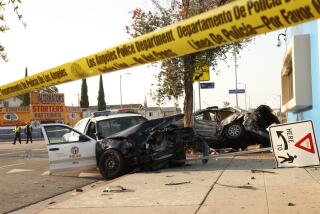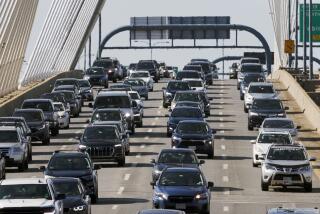Washed-Up Cars Trickle to Market
- Share via
ST. BERNARD PARISH, La. — As the vast vehicular wreckage wrought by Hurricane Katrina is carted away, law enforcement and insurance officials are anticipating the arrival of tens of thousands of those vehicles on used-car lots across the nation.
Already there is anecdotal evidence of flood-damaged vehicles turning up on lots in Florida, Arizona, New York and Oklahoma, authorities said. Two months ago, at least seven 2005 Nissans listed in the National Insurance Crime Bureau database as hurricane-damaged were sold at an auction in Los Angeles.
A task force of insurance investigators and Louisiana law enforcement officials is building a database of flooded cars to try to prevent vehicles from being spruced up and foisted upon unsuspecting used-car buyers. The database at www.nicb.org lists more than 205,000 vehicles.
On a brisk afternoon this month, Tim Boucher stood in the median of a four-lane road in St. Bernard Parish checking the paperwork of truck drivers hauling away Katrina-damaged vehicles.
Boucher, a special agent with the National Insurance Crime Bureau working on the database, said: “It’s really going to be incumbent upon the consumer to check.”
As he spoke, sport utility vehicles with an inch of mud and straw on the floor, minivans with seats cracked and puckered by water, and one car after another with the rank smell that comes from being submerged in muck were towed away.
Four months after Katrina swamped New Orleans and pounded the Mississippi coastline, thousands of vehicles remain on streets or buried under wreckage. Thousands more have been towed away into the murky and lucrative world of salvage cars.
Though most experts agree that cars that have been submerged in saltwater should never be driven, they also agree that as many as half of the vehicles that were damaged by Katrina probably will be rebuilt and resold.
About half of an estimated 500,000 vehicles that were damaged by the storm weren’t covered by comprehensive insurance, and with no insurance money to buy a replacement, the owners may be enticed to clean them up and resell them.
Another factor encouraging resales is loopholes in the nation’s system for tracking vehicles that have been totaled.
If a flood submerges a vehicle, many states require that the title reflect the damage by listing the car as “salvaged” or “flood-damaged.” But experts agree that it is relatively easy for a rebuilder to buy a flood-damaged vehicle at auction, fix it up and “wash” the title of any evidence of the flooding by obtaining a new title in a state where title laws are weaker.
“What the smart individual who wants to be deceptive will do is take that title to another state like Arkansas, do a title washing and then take that car to Illinois as an Arkansas vehicle with no salvage on the title,” Boucher said.
Herb Lieberman, an automotive recycler based in Santa Fe Springs, Calif., and a board member in the Automotive Recyclers Assn., is among those in the salvage industry who hope that the Katrina disaster gives some momentum to a long-stalled effort to complete a nationwide database of vehicle identification numbers.
With a database, state officials could easily track an automobile’s state-by-state lineage before issuing a new title; currently, about half of the vehicles in the nation are listed in an identification number registry.
Salvage dealers also are drawing up proposed federal legislation that would create a national standard, a “certificate of destruction,” for cars that are totaled.
Under the proposal, when a licensed mechanic or insurance adjuster determines that the cost to repair a car exceeds its cash value, its identification number would be permanently retired. That would mean the vehicle’s owner couldn’t obtain a new title in another state, or slap the number of a totaled car onto a stolen auto of similar make, model and year.
Without such legislation, said Jim Watson, president of the Automotive Recyclers Assn., “We’re going to see these [flood-damaged] cars in the market for the next three or four years.”
Such legislation has previously been opposed by the insurance industry because rebuilders pay more for salvaged cars than scrap companies do.
The removal of flooded vehicles is part of a broader effort, overseen by the Federal Emergency Management Agency, to clear debris that stretches for 100 miles along the Mississippi coastline and into the New Orleans metropolitan area.
Because there is a thriving market for stolen vehicles, autos are being handled differently from the rest of the debris. Identifying and tracking the hurricane-damaged vehicles not only prevents fraud but makes it easier for the vehicle’s owner -- or the insurance company -- to recoup some of the vehicle’s value by selling it to a rehabber or for scrap. An analysis by the consulting firm Towers Perrin estimated that insured losses from damaged automobiles ranged from $1 billion to $2 billion.
Experts warn that a car that has sat in saltwater is bound to have problems, even if it is repaired. Saltwater corrodes metal parts, gums up joints and damages electrical and computer systems, potentially ruining air bags, among other things. Another problem is that the water could leave behind traces of mold, chemicals or E. coli bacteria in the vehicle’s interior.
“To me, the biggest concern about cars that are sitting in brackish water is air bags,” said Lt. Allen Carpenter, head of the Louisiana State Police insurance fraud section. “You’re dealing with a corroded sensor that may or may not work.”
To create a database of vehicle identification numbers from flood-damaged cars, a plan was devised in which local governments would tow vehicles to designated lots, where state police and insurance investigators would jot down the numbers and plug them into the database.
But the plan didn’t work because most of the parishes were too overwhelmed with other problems.
In Louisiana, the state police, along with the National Insurance Crime Bureau, took over the task Sept. 30, a month after the storm hit, and they have been trying to catalog as many as 350,000 damaged vehicles in the New Orleans area since. Besides the checkpoint in St. Bernard Parish, police and insurance investigators are going street by street in New Orleans and writing down vehicle identification numbers.
The challenges they face are evident in the Lower 9th Ward, which was devastated by a levee rupture. On a recent tour of the neighborhood, there were demolished cars scattered on streets, pushed up against trees and crushed beneath houses that were lifted off their foundation.
“When you start hearing estimates of 350,000 cars and there are 28 of you, and as many [insurance bureau] agents, that’s a lot of cars,” said Louisiana State Police Sgt. Gary Bridges. “It’s a huge job.... You tell the guys, ‘This has never been done on this scale.’
“It’s kind of hard to pump them up because you don’t know how long you’re going to be doing this,” he said. “You just have to keep your sense of humor.”
Andrew Martin reported from Louisiana and Andrew Zajac reported from Washington.
More to Read
Sign up for Essential California
The most important California stories and recommendations in your inbox every morning.
You may occasionally receive promotional content from the Los Angeles Times.










